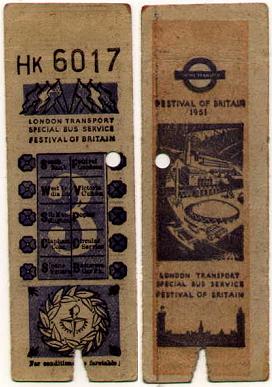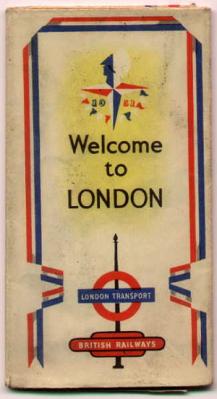 |
 |
| Festival of Britain bus tickets, showing destinations on one side and the South Bank exhibition site on the other. | A map issued for the Festival of Britain showing transport arrangements in London for LT and BR. |
 |
 |
| Festival of Britain bus tickets, showing destinations on one side and the South Bank exhibition site on the other. | A map issued for the Festival of Britain showing transport arrangements in London for LT and BR. |
| HOLD VERY TIGHT PLEASE.....
(an article from the "Festival Times" newsletter no. 15 of Spring/Summer 1993)
A: Connected the Science Exhibition and the Underground at South Kensington with Battersea Gardens. At South Kensington the buses picked up in Pelham Road and at Battersea the stop was in Albert Bridge just south of the Parkgate Road entrance. Fare was 3d. Six buses were allocated to this route and were kept at Battersea Bus garage. B: Connected the Underground at Sloane Square with Battersea. The stop at Sloane Square was in Holbein Place and this then ran through to Queenstown Road and terminated by the Chelsea Bridge entrance to the Gardens. The fare was 3d. 8 buses were allocated to this route and were nominally kept at Norwood Bus Garage. A shortage of space meant that in reality they were kept in a special compound in front of the nearby Norwood tram depot. C: Linked the Festival Gardens with the South Bank Exhibition site. The buses departed from a stop in the Prince of Wales Drive west of the Queens Circus entrance to the Gardens and terminated in York Road. The fare was 6d. Altogether 40 buses were allocated to this service and they were split up between the garages- 15 were kept at the Poplar trolleybus depot (although their official designation shows 5 at Athol Street (Poplar), 5 at Forest Gate and 5 at Clay Hall. The latter being of interest in that it was built of the site of the pleasure gardens that once stood at Old Ford.) 10 were kept at Camberwell and 15 were kept at Pecham? - although 5 of these were officially allocated to Catford. D. This was part of the river/bus service to Lansbury and connected West India Dock Pier (Manila Road) with Saracen Street. Return journeys to the pier started from Canton Street. The fare was 1.5d and there were 2 buses allocated which were kept overnight at Poplar trolleybus depot. E. This gave a connection between the South Bank and both Victoria Coach Station and the Green Line at Ecclestone Bridge by using a terminus on Elizabeth Bridge. The fare was 6d. and 4 buses were allocated from Victora Garage. F. This served to connect the large coach parking area set up on Clapham Common near Clapham South tube station with the Festival Gardens (Prince of Wales Drive terminus). 6 buses were allocated from Elmers End Garage and the fare was 6d. G. This was a 'Park and Ride' fore runner and provided a continuous linking service between car parks and the South Bank. The car parks served were at Lavington Street (between Blackfriars and Southwark Bridges), Southwark Street, three sites in Blackfriars Road, and Lambeth Baths. The fare between these and York Road was 3d. 4 buses were allocated and kept overnight at Camberwell. H. Connected the Festival Gardens car park at Patmore Street with the
Festival Gardens (Prince of Wales terminus). A low bridge meant that the
nearest the service could get to the car park was Ascalon Street. The fare
was 3d. and two buses were allocated from Streatham Depot.
One further 'lettered' service was also introduced and this was service 'J'. This was really the forerunner of the Round London Sightseeing Tours which are a familiar sight in London these days. For two shillings and sixpence you could spend two hours on a circular tour taking you "Around the town for half a crown". The service had hourly departures and used the four RT type buses that had spent the previous year touring Europe promoting the Festival of Britain. These four buses RTs 1692, 1702, 3070 and 3114 were based at the Old Kent Road. Three pick up points were provided at Buckingham Palace Road, South Kensington Station (Cromwell Place) and Bloomsbury (Southampton Row). Service 'J' started operation on June 11th 1951 and operated daily from 10.00am to 4pm. Because of the different opening times of the various sites some of
the routes started operation before others. Route D started operation on
May 3rd and ran every day from about 10.15am to 9.00pm. Routes E and G
started on May 4th and ran daily during the exhibition hours. Routes A,
B, C, E, F. and H started on May 11th and ran Monday to Saturday when the
Festival Gardens were open. A Sunday service on these routes started on
June 3rd.
|
The Festival of Britain http://www.packer34.freeserve.co.uk
This page was designed and is maintained
by Toby and John King, I would accept any comments or questions See
Index Page